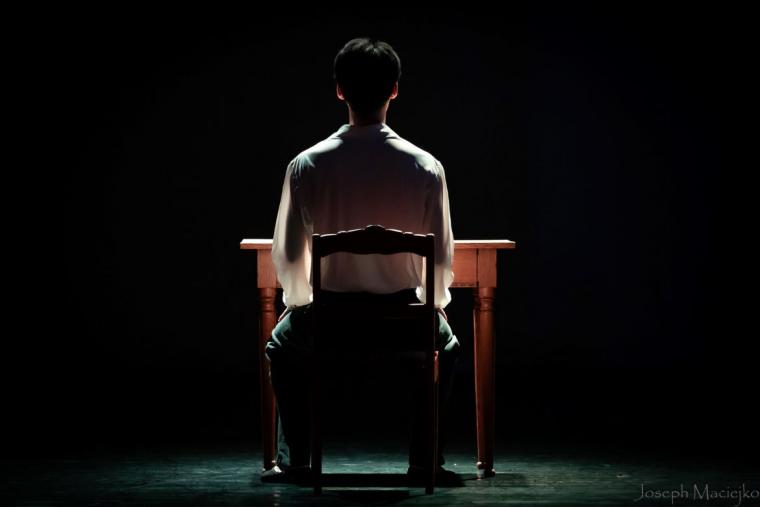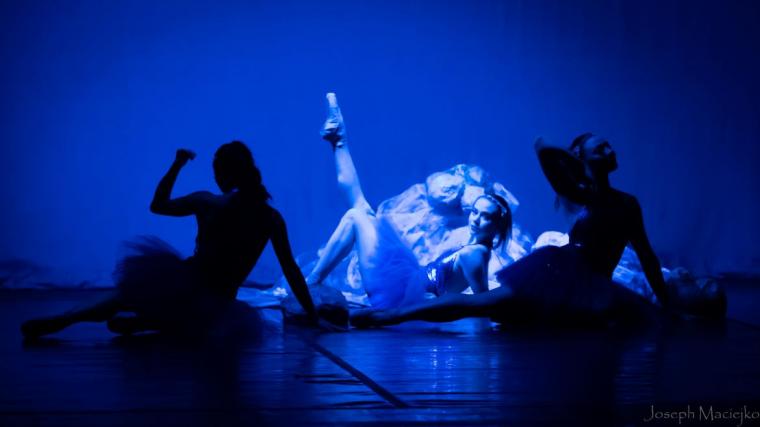
Ballet Quad Cities' "The Twisted Tales of Poe" at the Spotlight Theatre -- October 19.
For the professional dance company's annual, Halloween-themed presentations, the talents of Ballet Quad Cities are turning to the alluring literary creepiness of Edgar Allan Poe, delivering the unsettling yet exhilarating octet of The Twisted Tales of Poe. With the original ballet enjoying two performances at Moline's Spotlight Theatre on October 19, patrons will be treated to vignettes based on seminal works including “Annabel Lee,” “The Raven,” and “The Tell-Tale Heart.” But despite the author's 19th-century output, audiences shouldn't expect a performance of traditional 19th-century dance – not unless folks in the 1800s were also hoofing it to Jefferson Airplane, Led Zeppelin, and Jimi Hendrix.
Those three rock acts and three of their most iconic songs – “White Rabbit,” “Whole Lotta Love,” and “Purple Haze,” respectively – will be showcased in Ballet Quad Cities' Act I closer “The Tell-Tale Heart,” which, along with the vignette's preceding four pieces, I was fortunate to view in a September 19 rehearsal at the company's Rock Island studio. It's not unusual to see these gifted dancers going wild on the stage (or, in this case, the rehearsal room). It's not often, however, that you get to see them go crazy, and watching Christian Knopp's paranoid murderer ward off the police – re-imagined here as intimidatingly severe go-go-dancers – while attempting to stifle the thump-thump-thump in his head was a juicy, kinetic thrill.
I could say the same of the other four pieces I watched: a brief opener introducing Knopp as Poe himself; “The Oval Portrait,” with Knopp and Eleanor Ambler dancing a pas de deux (accompanied by Beethoven's Moonlight Sonata) that was somehow simultaneously erotic and melancholic; “Annabel Lee,” an adaptation of Poe's lyric poem that finds Mikaela Guidice's titular figure gracefully intertwined with a quartet of angels (Sierra DeYoung, Caitlin Sendlenski, Jillian Van Cura, and Mahalia Zellmer); and “The Raven,” in which six dancers (Ambler, DeYoung, Zellmer, Madeleine Kreszenz, Madeleine Rhode, and Kira Roberts) collectively play the “Nevermore”-spouting bird while Knopp and Marcus Pei perform some of the most stunning, acrobatic moves I've witnessed in years. (Given the strength of this company, that's saying a lot.)
As The Twisted Tales of Poe's choreographer and BQC artistic director Courtney Lyons explained following the September 19 rehearsal, we actually have a fan of last year's “Raven” staging to thank for this year's full night of Poe.
“'The Raven' you saw today is almost eight minutes long,” said Lyon. “But I did a shorter version of it last year. We did a few short pieces before last year's Halloween show The Headless Horseman. 'The Raven' was one that worked really well, and some audience member commented, 'You know, I could watch that again and again. I'd come back tomorrow night just to see that five-minute piece.'”
That comment, Lyons continued, wasn't lost on either her or Ballet Quad Cities CEO and founder Joedy Cook. “So Joedy asked me, 'What do think about, a year from now, doing a full-length Poe?' At the time, I said, 'Yeah, that sounds great!' And then, you know, several months later, I was like, 'Oh boy … okay … what have I gotten into?' Because there's no score. There's no soundtrack for it.
“But the sky's the limit on what stories you can choose,” Lyon said “There's a lot about lost love, and death … . So it was fun to dig through and pick pieces that would let me create different experiences as the ballet goes on.”

Lyon said one of the principal pleasures of choreographing The Twisted Tales of Poe involved the creativity such an opportunity offered.
“A lot of times in classical ballet, or in ballet traditionally, there's 'a version' of something – a particular Nutcracker or Swan Lake or Sleeping Beauty that people associate with that ballet. With Poe, it's not like that. Poe was never turned into a ballet. But nowadays, people are starting to adapt the literary works of authors, even 20th-century American authors. Poe, obviously, goes back further than that. But there's so much intrigue and mystery in his work, and I think before, ballet was used to tell supernatural stories or fairy tales. Now, currently, choreographers – and audiences, too, I think – are much more interested in psychological stuff, and Poe offers us things like unreliable narrators where you can't tell if you're being told the truth.
“And his words are so fun in the alliteration and the repetition – it leads right into dance,” said Lyon. “I've had the best time working on this, and the dancers have been fully invested in this with me. They're reading the stories along with me and we talk about them as I'm creating the choreography.”
She also enjoys the chance to depart from many people's perceived notions of what ballet is, or perhaps should be, as in her incredibly athletic staging of “The Raven” that requires Knopp, on numerous occasions, to lift and carry the slightly taller, equally muscular Pei.
“With a classical ballet,” said Lyon, “it's traditionally a man picking up a woman and carrying her above his head and throwing her and catching her, and the guy cannot show any effort. It's unlike weight-lifting, where you dig really deep and have your certain way of breathing and you grunt and all that. But for ballet, you can't show any of that, so dancers are trained to literally keep their heart rates as low as possible when they dance. They have to have the stamina of marathon runners – but then they also need to sprint sometimes, and like football players, they need to tackle.
“And they also can't show any effort when they're dancing because they're becoming characters or they're becoming atmosphere. They're telling a story. What's happening inside of them, the physical reality – that's what they're trained to not show.”
This also requires Ballet Quad Cities' company members to be as committed to acting as they are to dancing. “Some ballet training programs offer acting courses and improv classes, and you learn a lot of breath work,” Lyon said. “You get the chance to take on different characters and get coached, and there's a lot of hands-on experience. Facial expressions are also so important. And we do a lot of movement analysis where we talk about 'direct and heavy' or 'light and floaty' – ways of moving your body to show emotion, and using different planes of space. There's a lot we talk about.”
There's also a lot that dancers have to simply feel, as Lyon's artists clearly are in the psychedelic “Tell-Tale Heart” vignette that closes Act I.

“It came to me in a dream, Mike,” said Lyon, laughing, when asked about the inspiration to score this Poe work to Jefferson Airplane, Zeppelin, and Hendrix. “I don't know! I was just pulling from different music sources. I mean, I could pull from 1840s or 1850s music … you know, sometimes you pick the music from the time period to match the story. But in the 1850s, American music was not really dance music.
“So I was looking for music with a more Gothic feel. That led me to classical music that had haunting feelings, and that led me to psychedelic music. And I wanted those three songs because, in the story, the three cops come to the house, and the man who's buried the older man under the floorboard is paranoid and thinks he hears the heartbeat. He tells the cops 'Yeah, there's nothing going on.' But he's hearing this heartbeat, he thinks everyone can hear the heartbeat … . I think it's his own heartbeat he's hearing, or he's just going mad. But the music just seemed right to me – that psychedelic feeling of losing your mind.”
Lyon added that performing The Twisted Tales of Poe at the Spotlight, where the show will be lit by the venue's co-owner Brent Tubbs, is ideal, given that the space “already has a Gothic feeling to it – this Victorian Gothic feel. It also has a really nice setup in that the audience gets really drawn into the stage. It's an intimate stage space – at least compared to the Adler, of course.
“And the audience is kind of wrapped around [the production],” she said. “I like to bring the dancing to the audience, so for some of the pieces, the dancers will be coming through the audience and interacting. It's going to have very theatrical lighting, as well, and not traditional dance lighting. I'll be working with Brent on really theatrical lighting for this – a rock-concert look.”
Although I wasn't able to see a rehearsal of Act II, the repertoire for that half of the ballet is composed of: “The Bells,” a solo performance, based on another Poe poem, showcasing Sendlenski at 2 p.m. and Van Cura at 7:30 p.m.; “Ligeia,” scored to Mozart's famed Requiem in D minor, Lacrimosa and danced by Pei as an opium-addicted husband and DeYoung and Rhode as the man's two deceased wives; and “The Cask of Amontillado,” a group number for the entire Ballet Quad Cities company taking place during carnival season in Italy. This latter vignettes involves copious wine consumption, a crypt of bones, and the Latin phrase meaning “May he rest in peace.”
“You saw Act I,” Lyon told me. “Act II just gets wilder and wilder from there.”
Ballet Quad Cities' The Twisted Tales of Poe will be performed at the Spotlight Theatre (1800 Seventh Avenue, Moline IL) on October 19, admission to the 2 and 7 p.m. productions is $22.13-32.64, and more information and tickets are available by calling (309)786-3779 and visiting BalletQuadCities.com.










